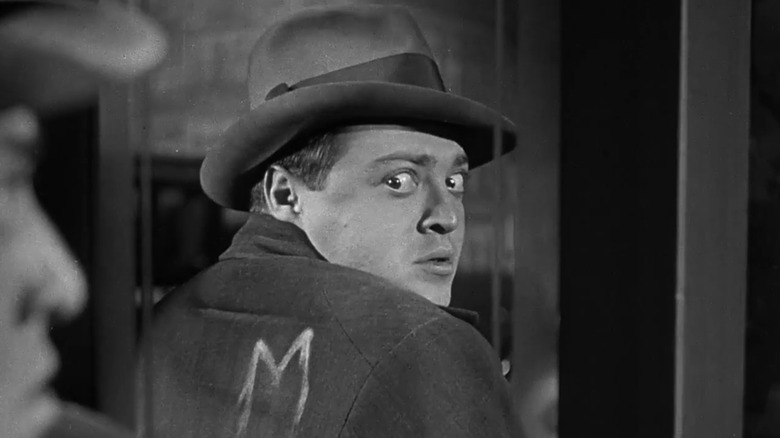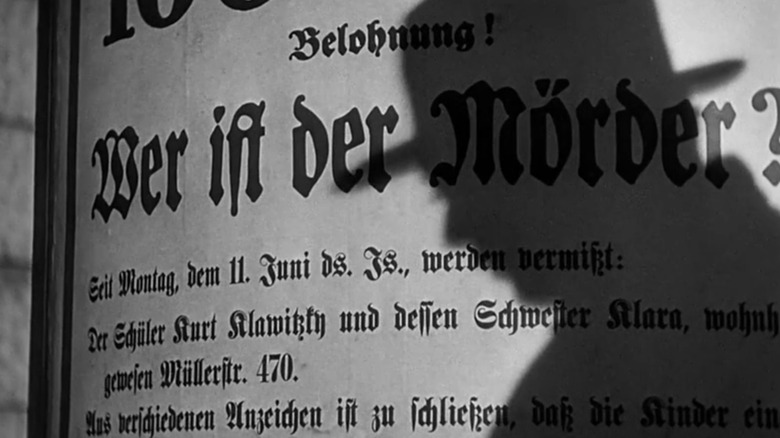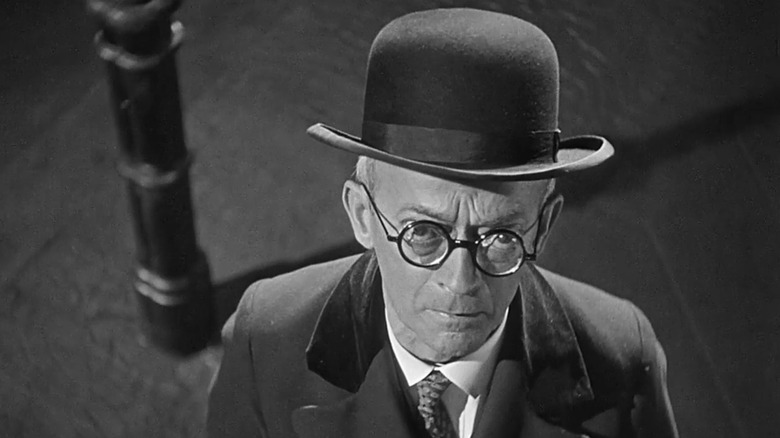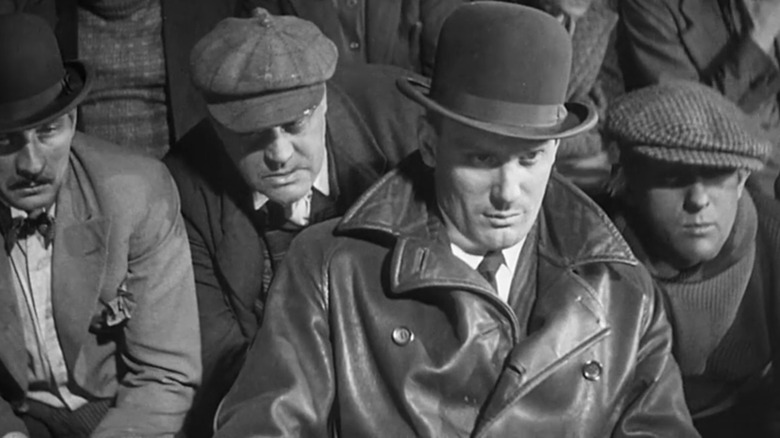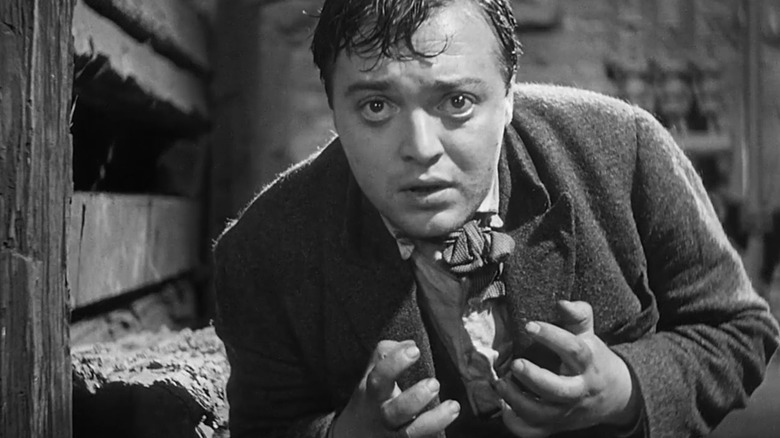The Daily Stream: 90 Years Ago, Fritz Lang's M Laid The Groundwork For Every Serial Killer Thriller You've Ever Seen
(Welcome to The Daily Stream, an ongoing series in which the /Film team shares what they've been watching, why it's worth checking out, and where you can stream it.)
The Movie: "M"
Where You Can Stream It: The Criterion Channel / HBO Max
The Pitch: A killer stalks Berlin, plying children with balloons and candy, igniting a citywide manhunt, and exposing a cross-section of society in 1930s Germany.
Before there was "Zodiac" or "Memories of a Murder," there was "M." Fritz Lang's German Expressionist masterwork was on the bleeding edge of sound films, and in his Great Movies review, Roger Ebert noted that it birthed the genres of "the serial killer movie and the police procedural."
The first quasi-talkie, "The Jazz Singer," had arrived four years earlier, and sound was starting to spread across the motion picture medium. You may have seen or heard of other Lang films, like "Metropolis," or other German films, like "Nosferatu: A Symphony of Horror," made before this, but those were silent films. "M" is perhaps the oldest movie with sound to have achieved an inviolate place in the canon of the greatest films of all time.
To see "M" for the first time is to experience the sensation of a gastronome, perhaps a food critic like Anton Ego in "Ratatouille," being awakened to the knowledge that all his favorite chefs were cribbing from the same secret recipe. You think you've seen it all but then you're overcome by an explosion of taste, and you can't believe it's coming from such an early film, one that predates almost everything you've seen up to this point.
Why It's Essential Viewing
"M" is a must-see for genre fans and students of film history. Anyone who loves a good thriller will find much here to engage their senses. The film opens with a girl standing in a circle of children on a playground, doing a dark German version of, "Eeny, meeny, miny, moe." She sings, "The man in black will soon be here with his cleaver's blade so true. He'll make mincemeat out of you!"
One, two, Freddy's coming for you. Him, and Candyman and a whole host of other murderers and monsters, who stalk the celluloid annals from suburban houses to inner-city housing projects. "M" is at the root of a twisted film family tree that includes many branches.
On this street, a shadow falls over a wanted poster. That's Peter Lorre, a Jewish actor who soon left Germany for Hollywood after Adolf Hitler became head of state. Lorre would appear in a number of classics, including "The Maltese Falcon" and "Casablanca," both with Humphrey Bogart. In "M," his character, Hans Beckert, whistles "In the Hall of the Mountain King" and writes to the newspapers, while the police analyze his postcards for handwriting and fingerprint samples. This was 1931.
In 2021, we revisited both Jonathan Demme's "The Silence of the Lambs" and David Fincher's "Seven," two of the most influential serial killer thrillers of the 1990s. Yet "M" prefigured both of them, showing a killer mugging for the mirror and cops sleeping on benches at the station. Lang's use of POV shots — where the camera takes on a character's perspective, looking around the room or into another character's eyes — are particularly evocative of techniques Demme would use sixty years later.
'A City Searches for a Murderer'
In "M," Fritz Arno Warner, the same cinematographer who filmed Count Orlok creeping up the staircase in "Nosferatu," guides us around smoke-filled barrooms and through windows. The all-seeing camera eye is always poised in the act of looking, observing snapshots of life. Ebert wrote, "Many early talkies felt they had to talk all the time, but Lang allows his camera to prowl through the streets and dives, providing a rat's-eye view."
There are some patches where the sound drops out altogether, putting us halfway back in the silent era. High-angle shots visually reinforce the powerlessness of an old man in the face of a tall accuser and vigilante mob, while a low-angle shot from the floor (rat's-eye view, indeed) frames the crotch and paunch of a police inspector as he lounges in his desk chair, talking on the phone. Lang also makes interesting use of cutaways to different locations, showing a watchman drinking beer and eating sausage while officials are talking about him, and showing witnesses arguing over the color of the missing girl's cap in the middle of the police commissioner's phone call.
The procedural aspects of "M," its detail-oriented focus on signs, newspapers, maps, and police reports, also serve as an early analog precursor to the online research we would see decades later in thrillers like "The Girl with the Dragon Tattoo" and "Searching." The film's full German title, "M: Eine Stadt sucht einen Mörder," translates as, "M: A City Searches for a Murderer." Though the aforementioned "Zodiac" was based on a real-life case, it's hard not to think of it, given the similarities and lines of dialogue like the one in "M" where one criminal describes another as "the best from Berlin to San Francisco."
The Devil and Gustaf Gründgens
Lang weaves a tapestry of urban decay and prewar German society on all levels, juxtaposing a meeting of city officials with a meeting of syndicate bosses, led by the Safecracker (Gustaf Gründgens). The crooks are out to get Hans because he's bad for business. The cops keep busting up their underground establishments while the real killer eludes them.
Like Lorre, Lang bore Jewish descent, and he, too, fled Germany after the Nazis took power. Gründgens, a known homosexual, reentered the country and managed to avoid the gas chamber through lavender marriages and his fame as an actor. Some sources make him sound like a low-key Oskar Schindler, using his position to protect people. Others, like WSWS, paint a less flattering picture of a purblind careerist who benefited from his connections to the war criminal Hermann Göring.
Klaus Mann based the protagonist of his roman à clef novel, "Mephisto," on Gründgens. The 1981 film adaptation won Hungary its first Oscar for Best Foreign Language Film. It's about a stage actor and theater director who thrives in Nazi Germany, playing a pancake-white Mephistopheles in "Faust," only to realize that he's made his own Faustian bargain with a real-life Nazi devil and that his greatest role is the one he plays offstage.
If you haven't seen many German films, hearing the language spoken in a 1930s setting by Gründgens' Safecracker — a blonde in a Gestapo-like black leather trench coat — is sure to add another unsettling layer to "M." The Safecracker himself is a three-time accused perpetrator of manslaughter, and Lang's film surprises in how it seeds in debate about capital punishment and lays bare the hypocrisy of the Safecracker's kangaroo court presiding over a compulsive killer like Hans.
Peter Lorre's Moment and the Long Shadow of "M"
As the net closes in around Hans, he goes from being a phantom to a fully realized psyche: branded with a chalk "M," cornered and cowering in the shadows of an office building, delivering a mesmerizing monologue in a basement distillery where he's surrounded by accusing faces. Lorre was often typecast as a villain — he even showed up as a mad scientist in a couple of Bugs Bunny cartoons — but seeing this multilingual actor cut loose in German is the stuff of Shakespeare. As Hans, he gesticulates forcefully and speaks of having a "cursed thing inside" him, saying:
"I have to roam the streets endlessly, always sensing that someone's following me. It's me. I'm shadowing myself. ... And with me run the ghosts of the mothers and their children."
Should a man as sick as Hans be turned over to a doctor or executioner? Lang leaves that question echoing in the hall of the mountain king (cue the Seattle Symphony).
Justice, here personified as a sightless balloon seller, is literally blind. Lang notably cuts away from the judges before the reading of the verdict to show the grieving mothers sitting on the sidelines. "This will not bring our children back," one of them says, before looking right into the camera.
"M" is the granddaddy of all serial killer thrillers. It casts a long shadow over the genre and even post-war noir and teen slashers, where the villains have their own lullabies and leitmotifs and they come back for revenge on the children of those who tormented them. This ghost still haunts, and if you haven't already seen "M," it's one of those titles that needs to skip to the top of your movie bucket list.
